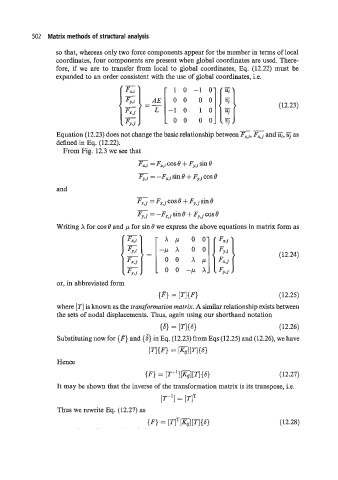Page 521 - Aircraft Stuctures for Engineering Student
P. 521
502 Matrix methods of structural analysis
so that, whereas only two force components appear for the member in terms of local
coordinates, four components are present when global coordinates are used. There-
fore, if we are to transfer from local to global coordinates, Eq. (12.22) must be
expanded to an order consistent with the use of global coordinates, i.e.
--
Equation (12.23) does not change the basic relationship between Fx,i, Fx,j and i& as
defined in Eq. (12.22).
From Fig. 12.3 we see that
-
Fx,i = Fx,i cos 8 + Fy,i sin 8
= -Fx:i sin 8 + Fy,i cos 8
and
-
Fx,j =FxJcos8+ FY;,,sin8
-
Fy,j =-Fx,jsin8+ Fy,jcos8
Writing X for cos 8 an ,u for sin 8 we express the above equations in matrix form as
I B
-k 00-pX :]{;y,j,
or, in abbreviated form
IF1 = [mF} (12.25)
where [TI is known as the transformation matrix. A similar relationship exists between
the sets of nodal displacements. Thus, again using our shorthand notation
= [TI{S} (12.26)
Substituting now for {F} and {J} in Eq. (12.23) from Eqs (12.25) and (12.26), we have
[TI{F} = [K,l[~I{S}
Hence
{F} = [T-'l[K,l[Tl{S} (12.27)
It may be shown that the inverse of the transformation matrix is its transpose, i.e.
[T-'] = [TIT
Thus we rewrite Eq. (12.27) as
{Fl= [TITm[7-l{s> (12.28)

